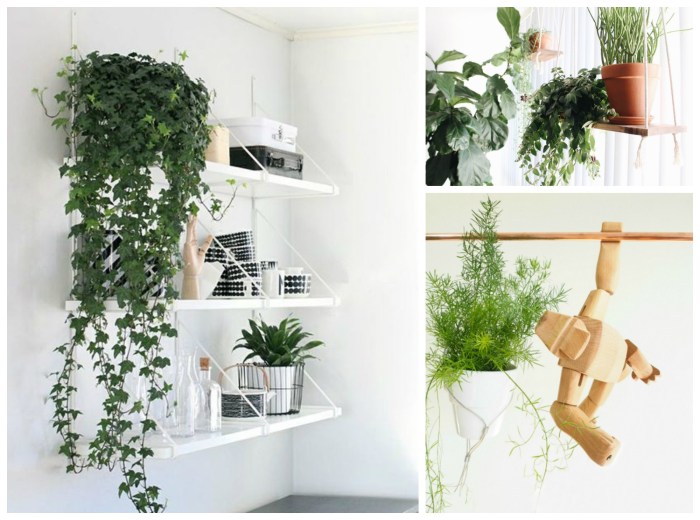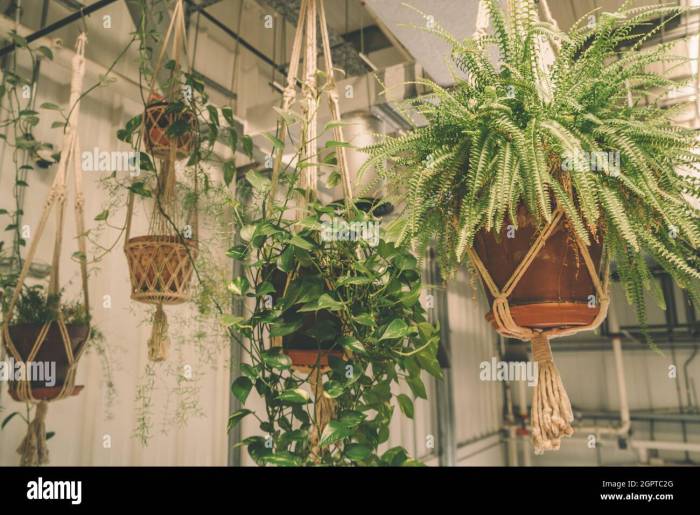With the resurgence of hanging plants as a stylish and space-saving decor solution, the question of “Can you put hanging plants in a pot?” has become increasingly prevalent. This guide delves into the intricacies of selecting, planting, and caring for hanging plants in pots, providing a comprehensive resource for both novice and experienced plant enthusiasts.
From choosing the right plants and pots to hanging methods and troubleshooting, this article covers everything you need to know about growing beautiful and thriving hanging plants in your home.
Plant Suitability for Hanging Pots
Hanging plants add a touch of greenery and elegance to any space. When selecting plants for hanging pots, it’s essential to consider factors such as size, weight, and light requirements.
If you’re considering adding hanging plants to your home, you may wonder if you can simply place them in a pot. The answer is yes, you can put hanging plants in a pot, but there are a few things to keep in mind.
First, you’ll need to choose a pot that is the right size for the plant. The pot should be large enough to accommodate the plant’s roots, but not so large that the plant becomes rootbound. You’ll also need to make sure that the pot has drainage holes to prevent the plant from becoming waterlogged.
Are hanging plants are a great way to add some life and greenery to your home, and they can be easily placed in a pot.
Suitable Plants for Hanging Pots
- Trailing Plants:Plants with long, cascading stems, such as pothos, philodendron, and spider plants, are ideal for hanging pots as they create a lush, flowing effect.
- Compact Plants:Smaller plants, such as succulents, ferns, and peperomias, can add a touch of greenery without overwhelming the space.
- Air Plants:These unique plants don’t require soil and can be attached to the pot using wire or glue, making them perfect for hanging.
Factors to Consider
When selecting plants for hanging pots, consider the following factors:
- Size:Choose plants that are appropriate for the size of the pot. Avoid plants that will outgrow the pot or become too heavy.
- Weight:Hanging pots can become quite heavy, especially when watered. Select plants that are lightweight and won’t strain the pot or its suspension.
- Light Requirements:Ensure that the plants you choose have similar light requirements to the location where the pot will be hung.
Determining Plant Suitability
To determine if a plant is appropriate for a hanging pot, consider its natural growth habit. Plants with trailing or cascading stems are typically well-suited for hanging, while upright or bushy plants may not be as suitable.
Pot Selection and Preparation
Choosing the right pot and preparing it adequately are crucial for the success of hanging plants. Different types of pots have their advantages and disadvantages, and selecting the most suitable one depends on the plant’s needs and the desired aesthetic.
Common materials for hanging pots include plastic, ceramic, terracotta, and metal. Plastic pots are lightweight, durable, and affordable, but they may not be as aesthetically pleasing as other materials. Ceramic and terracotta pots are more decorative, but they can be heavier and more fragile.
Metal pots are durable and stylish, but they can be expensive and prone to rust if not properly treated.
The size of the pot should be appropriate for the plant’s root system. A pot that is too small will restrict root growth, while a pot that is too large can lead to overwatering and root rot. It’s generally recommended to choose a pot that is 2-3 inches wider than the root ball.
Drainage holes are essential for hanging pots to prevent waterlogging. If the pot does not have drainage holes, you can create them yourself using a drill or a sharp object. The holes should be large enough to allow excess water to drain out freely.
The choice of soil is also important for hanging plants. A well-draining potting mix is essential to prevent root rot. You can use a commercial potting mix or create your own by mixing equal parts peat moss, perlite, and compost.
Planting and Care Techniques
Planting and caring for hanging plants in pots require specific techniques to ensure their health and beauty. This guide provides step-by-step instructions and essential tips for successful cultivation.
Whether you’re looking to add a touch of greenery to your home or simply curious about the virtual world, you may be wondering if hanging plants can be placed in pots. While traditional gardening techniques may not allow for this, the world of Minecraft offers a unique solution.
For those interested in learning more about the various hanging plants found within the game, a comprehensive guide can be found at what are the hanging plants in minecraft . However, for those seeking to incorporate hanging plants into their physical spaces, it’s important to note that this technique is not applicable in the real world.
Planting
- Choose a suitable container:Select a pot with drainage holes to prevent waterlogging. The size should be proportionate to the plant’s root system.
- Prepare the soil:Use a well-draining potting mix specifically designed for hanging baskets or pots. Add organic matter, such as peat moss or compost, to improve soil structure.
- Plant the hanger:Remove the plant from its nursery container and gently loosen the roots. Dig a hole in the potting mix deep enough to accommodate the root ball.
- Fill and firm the soil:Backfill the hole with potting mix, gently pressing down to remove air pockets. Water the plant thoroughly after planting.
Watering
Hanging plants require regular watering, but avoid overwatering. Check the soil moisture by inserting your finger into the potting mix. Water when the top inch of soil feels dry.
Fertilizing
Fertilize hanging plants regularly during the growing season. Use a balanced liquid fertilizer diluted to half strength. Apply fertilizer according to the manufacturer’s instructions. Signs of nutrient deficiency include yellowing leaves, stunted growth, or poor flowering.
Hanging Methods and Placement

Hanging plants can add a touch of greenery and life to any space. But before you hang your plants, it’s important to choose the right hanging method and placement.The most common way to hang plants is with hooks. Hooks can be screwed into the ceiling or wall, and they come in a variety of sizes and styles.
Another option is to use chains. Chains can be draped over a beam or hook, and they can be adjusted to the desired length. Macrame hangers are a more decorative option. Macrame hangers are made of knotted cords, and they can be hung from the ceiling or wall.When
When considering whether to put hanging plants in a pot, it’s important to choose the right pot for the plant’s needs. For instance, if you’re looking for balcony hanging pots, you can explore the options available at balcony hanging pots bunnings . These pots are designed to withstand the elements and provide adequate drainage for your hanging plants.
choosing a hanging method, it’s important to consider the weight of the plant and pot. Heavier plants will require stronger hooks or chains. It’s also important to make sure that the hanging method is secure. You don’t want your plant to fall down and break.Once
you’ve chosen a hanging method, it’s time to decide where to place your plant. When choosing a placement, it’s important to consider the plant’s light, temperature, and space requirements.Most plants need bright, indirect light. Avoid placing your plant in direct sunlight, as this can scorch the leaves.
Some plants, such as ferns and peace lilies, can tolerate low light conditions.Plants also need warm temperatures. Avoid placing your plant in a cold draft or near a heat source.Finally, it’s important to consider the space requirements of your plant.
Some plants, such as trailing plants, need more space to grow. Make sure that you have enough space for your plant to grow and thrive.
Hanging Methods
There are several different ways to hang plants, including:
- Hooks:Hooks can be screwed into the ceiling or wall, and they come in a variety of sizes and styles.
- Chains:Chains can be draped over a beam or hook, and they can be adjusted to the desired length.
- Macrame hangers:Macrame hangers are made of knotted cords, and they can be hung from the ceiling or wall.
Placement
When choosing a placement for your hanging plant, consider the following factors:
- Light:Most plants need bright, indirect light. Avoid placing your plant in direct sunlight, as this can scorch the leaves.
- Temperature:Plants also need warm temperatures. Avoid placing your plant in a cold draft or near a heat source.
- Space:Finally, it’s important to consider the space requirements of your plant. Some plants, such as trailing plants, need more space to grow. Make sure that you have enough space for your plant to grow and thrive.
Troubleshooting and Maintenance
Hanging plants in pots offer a unique way to add greenery and life to any space. However, these plants can face specific challenges that require proper troubleshooting and maintenance.
Common Problems and Solutions
Yellowing leaves, pests, and diseases are common problems associated with hanging plants in pots. Yellowing leaves can indicate nutrient deficiencies, overwatering, or insufficient sunlight. Pests like aphids, mealybugs, and spider mites can infest plants, causing damage and yellowing. Diseases such as root rot and powdery mildew can also affect hanging plants.
- To address yellowing leaves, check the plant’s water and light conditions, and fertilize if necessary.
- For pest infestations, use insecticidal soap or neem oil to control the pests.
- To prevent diseases, ensure proper drainage and avoid overwatering. Fungicides can be used to treat existing diseases.
Regular Maintenance, Can you put hanging plants in a pot
Regular maintenance is crucial for the health and longevity of hanging plants in pots. Pruning helps control growth, remove dead or diseased leaves, and encourage new growth. Repotting is necessary as plants outgrow their pots, providing them with fresh soil and nutrients.
Cleaning the pots and leaves removes dust and debris, promoting photosynthesis and preventing pest infestations.
- Prune plants regularly to maintain their shape and size.
- Repot plants every 1-2 years into pots that are 1-2 inches larger.
- Clean the pots and leaves with a damp cloth to remove dust and debris.
Wrap-Up: Can You Put Hanging Plants In A Pot

In conclusion, hanging plants in pots offer a unique and versatile way to add greenery and style to your living space. By following the tips and techniques Artikeld in this guide, you can successfully cultivate healthy and vibrant hanging plants that will bring joy and beauty to your home for years to come.
Questions Often Asked
What are some popular hanging plants that are suitable for pots?
Some popular hanging plants that thrive in pots include pothos, spider plants, ferns, ivy, and trailing succulents.
How do I choose the right pot for a hanging plant?
Consider the size and weight of the plant, as well as the drainage and material of the pot. Terracotta pots are porous and allow excess water to evaporate, while plastic pots retain moisture better.
How often should I water my hanging plants?
Water your hanging plants when the soil feels dry to the touch. Overwatering can lead to root rot, so it’s best to err on the side of caution.